Sterling Silver vs Pure Silver: What’s the Difference?

Key Takeaways
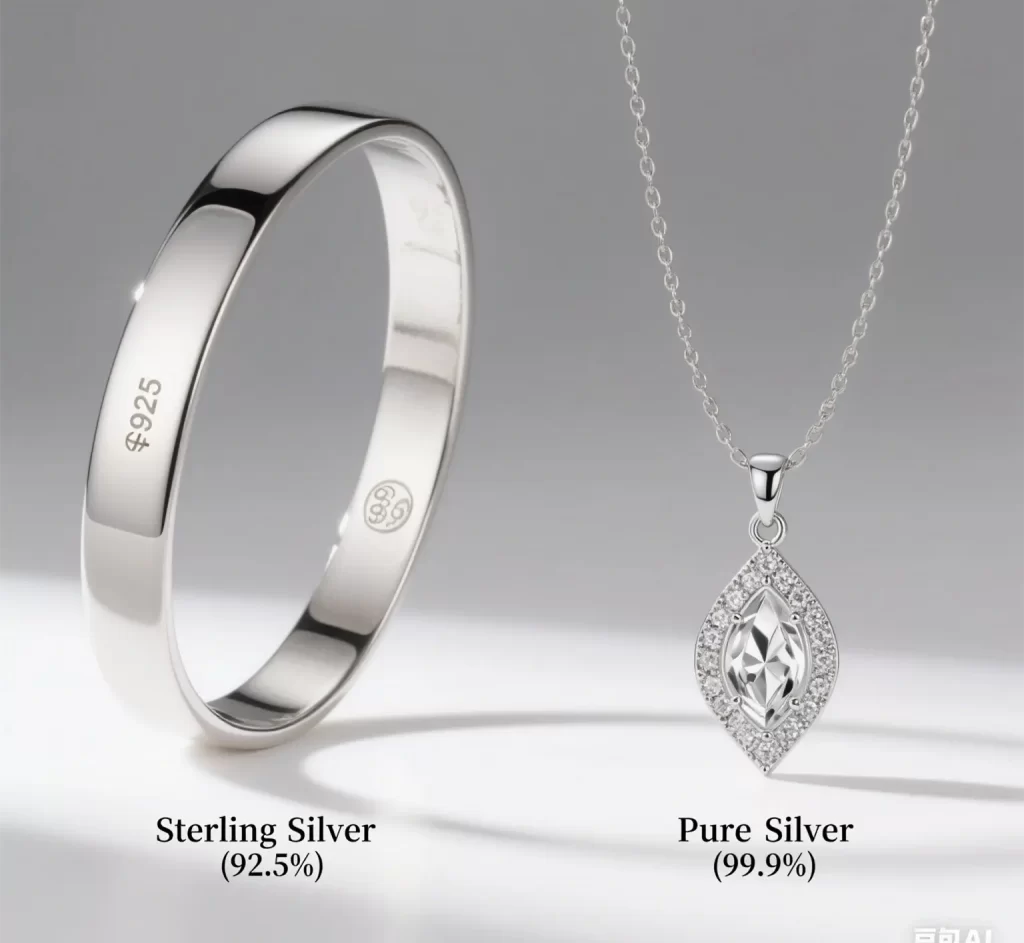
- This metal, called .999 fine silver, is 99.9% pure silver. Most people think of it when they think of investment pieces, collectibles, and fine jewelry because of its softness and brilliant luster.
- Sterling silver is stamped .925 and is 92.5% silver. The other 7.5% is other metals, such as copper, which lend strength and durability, making it ideal for jewelry pieces that might be worn every day and household items.
- Look for hallmarks (.999 or .925) when purchasing silver. These stamps authenticate both pure silver and sterling silver.
- Additionally, sterling silver provides the best value for day-to-day wear and tear. Conversely, pure silver makes sense for buyers prioritizing hypoallergenic properties or a long-term investment.
- Tarnishing happens faster in sterling silver because of the added metals, but regular cleaning, proper storage, and anti-tarnish pouches can help maintain the shine of both types.
- When deciding whether to use sterling or pure silver, consider how you’re going to use the piece. Besides quality, think about your budget and the importance of ethical sourcing to your purchase overall.
Understanding the difference between sterling silver vs silver is essential for anyone looking to purchase quality jewelry or silverware. Sterling silver and regular silver have distinct properties that affect their durability, value, and appearance. Sterling silver is an alloy made up of 92.5% pure silver and 7.5% other metals, often copper. Silver is the term used for pure silver, which is 99.9% silver. Both substances are popular in jewelry and flatware. When comparing sterling silver vs silver options, it’s crucial to understand their fundamental differences. The sterling silver vs silver distinction affects everything from durability to appearance and price.
What really makes sterling silver unique is its unbeatable strength and durability, provided by the additional metals. Without these elements, pure silver is much softer and bends or scratches much easier. In the US, the majority of jewelry that would be simply labeled “silver” is sterling silver for durability.
Legislation mandates unambiguous identification, so items will commonly be stamped “925” to indicate the piece is sterling. Understanding the differences makes all the difference when you’re shopping for gifts, heirlooms, or something you’ll wear every day.
The middle section walks you through how each type operates in the real world. It further suggests care tips and common uses in American homes.
What Is Pure Silver?
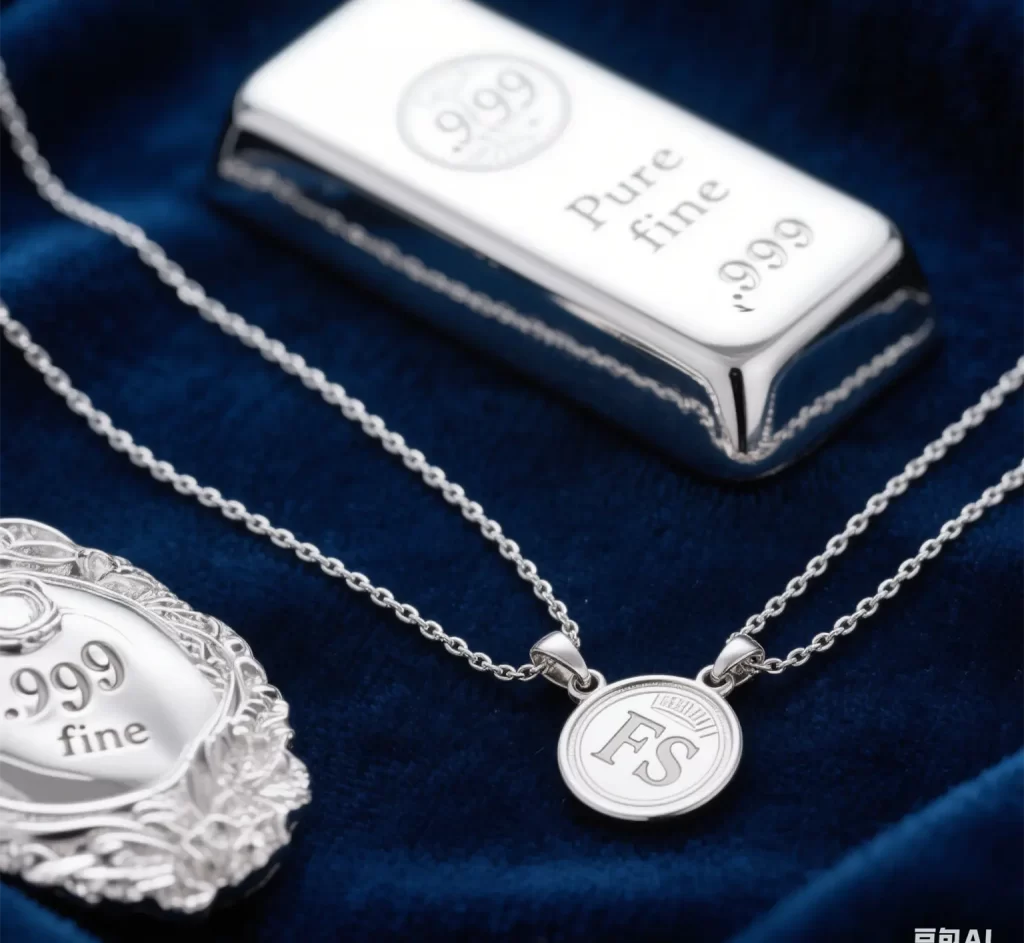
Pure silver, known as fine silver, is made up of 99.9% silver. Only a miniscule 0.01% is made up of trace elements. In the market, this level of purity is truly exceptional and carries a significant premium. In any sterling silver vs silver comparison, pure silver stands out for its exceptional purity level. When evaluating sterling silver vs silver for investment purposes, pure silver’s 99.9% purity gives it an edge.
It really sets itself apart, especially when you compare it to other more popular forms of silver that include other metals. Pure silver is most famous for its shiny, brilliant appearance and is used primarily in fine jewelry, collectibles, and coins.
What many consumers see are the stamps “999,” “.999 FS,” or “FS” on these products. These stamps unmistakably tell consumers that they are buying pure silver.
Defining .999 Fine Silver
When you read .999 on silver, it is a sign that the item is almost fully pure. There’s just a touch of impurities intermingled with it. Because this is an international standard, it’s easy to recognize quality silver in any part of the world.
To consumers, the “.999” hallmark stands as a recognizable mark of integrity, providing assurance that the piece is indeed crafted from pure silver. Investors many individuals purchase .999 fine silver in the form of bars, coins or bullion.
These stamps serve to distinguish genuine pure silver from the lesser grades.
The Soft Side of Silver
Pure silver is indeed softer than sterling silver. This softness may make it easier to work with but more difficult to maintain. Jewelry created with pure silver will bend, dent, or scratch more easily than their alloyed counterparts.
Due to the above, most pure silver is produced for display, coinage, or memento purposes, rather than high wear rings or bracelets.
Why Choose Pure Silver?
Benefits of pure silver Pure silver is especially gentle on sensitive skin because it doesn’t contain other metals. It tarnishes less than most alloys and maintains its shiny, bright appearance.
Its purity, combined with its high inherent value, makes it an intelligent investment for individuals interested in a safe investment.
Spotting the .999 Mark
To tell if an item is pure silver, search for the “.999” or “FS” stamp. You can look for these on the back, inside band, or rim of pieces. The .999 mark is important for determining that you are indeed buying pure silver, but be on the lookout for counterfeits.
Reputable suppliers, like HonHo Jewelry, go the extra mile to mark clearly and maintain quality. This dedication ensures that consumers can quickly spot authentic .999 pure silver.
What Is Sterling Silver?
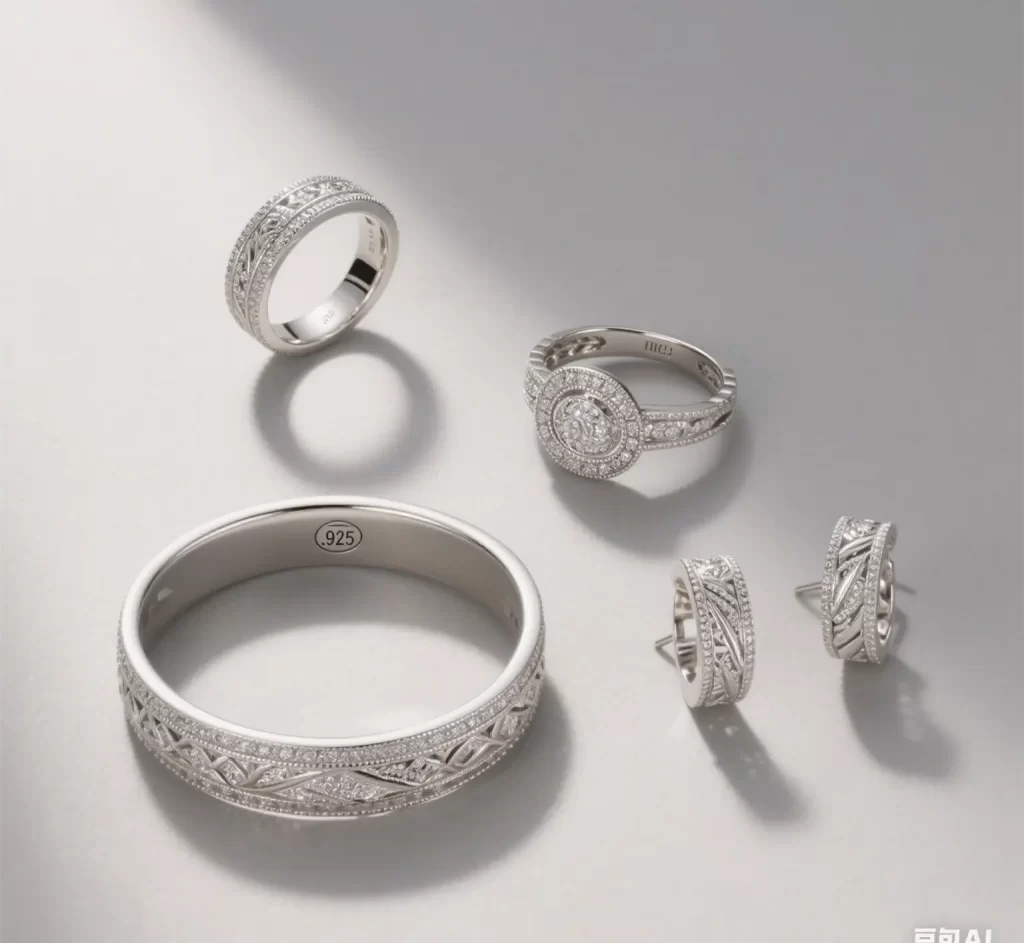
Sterling silver is a durable metal alloy that has long been prized in American jewelry and decorative household objects. In the sterling silver vs silver debate, this alloy consists of 92.5% pure silver and is normally combined with copper.
This fusion creates an alloy that’s much tougher than pure silver, which can bend and dent easily with the wear and tear of everyday use. By alloying in copper, jewelers and makers have a material that is both bright and sleek yet durable.
Sterling silver has been known for its intrinsic beauty and craftsmanship. It has been treasured as beautiful and practical in countless objects, from colonial flatware to modern rings and bracelets.
Today, it remains just as important in the jewelry industry, due to its mix of aesthetic appeal and durability.
Defining .925 Sterling Silver
The .925 marking refers to how much fine silver is in sterling silver—92.5%. This number is significant to the wider industry, as it provides an unmistakable threshold for quality.
When you buy a piece that is marked .925 or “Sterling,” you can be sure it’s up to this standard. Other countries might have their own variations of these marks, but .925 is what you will most commonly find in the U.S. Europe.
This is important because sterling silver and other precious metals are often faked or diluted by opportunistic makers hoping to sell customers a cheaper blend.
The Strength of Sterling
It’s adding the other metal copper, which provides sterling silver with its strength and durability. While pure silver is soft, the alloy is tough enough to withstand the dings of everyday life. This strength advantage is a key factor in the sterling silver vs silver comparison, especially for items that will see frequent use.
Assuming sterling pieces are well cared for they can last for generations and be polished to a high shine over and over. Popular brands such as HonHo Jewelry incorporate 925 silver into their custom, gold-filled, and waterproof designs, striking a perfect balance between style and substance.
Why Sterling Is So Popular
This is why sterling silver really finds that sweet spot of being shiny and pretty, but sturdy and strong. It accommodates dramatic designs, graceful necklaces and all styles in between.
Its lower cost compared to pure silver makes it a favorite for gifts and collections. In many cultures, it has historically been used for mementos, marriage rings, and other jewelry.
Finding the Sterling Stamp
Look for marks such as “925”, “Sterling”, or “STG” to find genuine sterling. You might see these stamps on the clasps or insides of rings. These hallmarks are crucial identifiers in the sterling silver vs silver marketplace, helping consumers make informed choices.
Make sure to look out for these in your purchases. While some makers do have their own specific stamps, the .925 mark is a universal and trusted sign of quality.
Sterling Silver vs Silver: The Ultimate Showdown
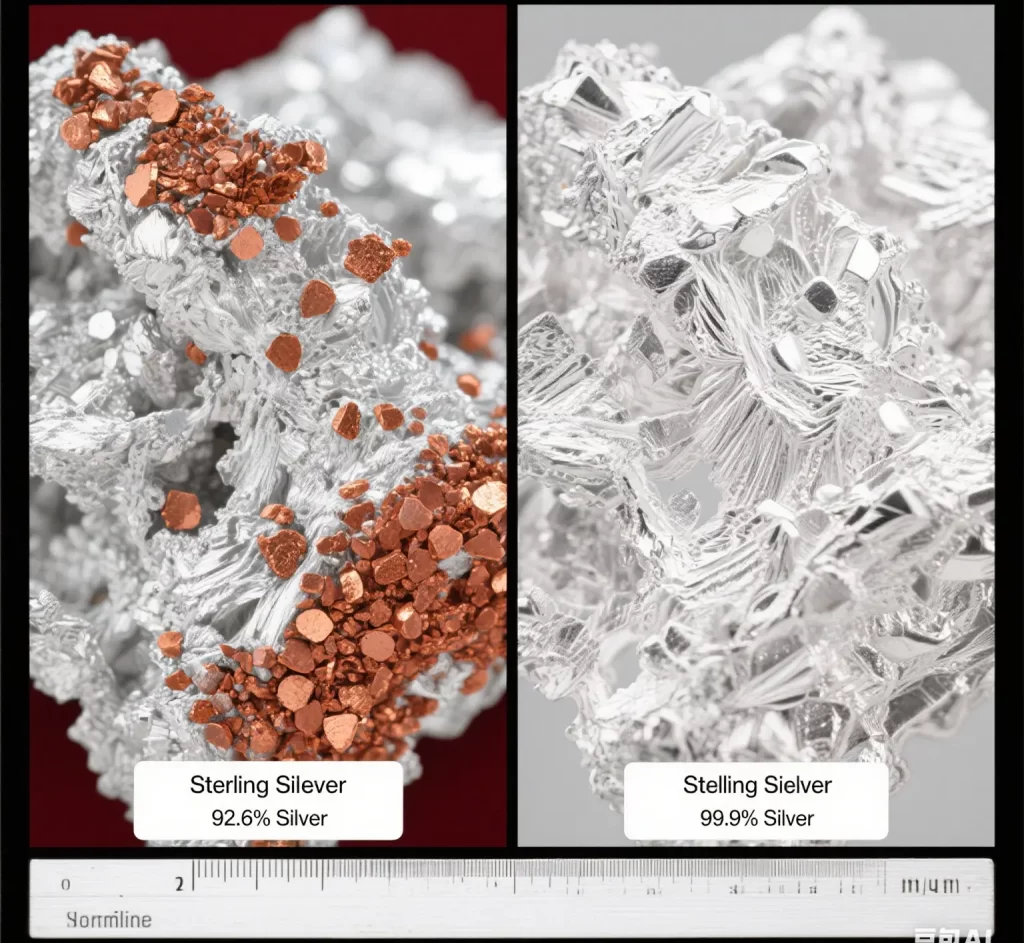
Whether you go with sterling silver or pure silver, your decision goes beyond selecting a pretty metal. The sterling silver vs silver comparison involves considerations of material composition, purpose, and care requirements. When evaluating sterling silver vs silver options, buyers, collectors, and makers in creative hubs like Los Angeles deserve the truth.
This understanding will help you make an informed decision as you build your program to find the best fit for your goals and needs. Let’s explore some of the distinctions between sterling and pure silver. We’ll find out how each type stacks up for regular use and long term.
Below is a quick reference table before diving into the details:
|
Feature |
Sterling Silver |
Pure Silver (Fine Silver) |
|---|---|---|
|
Silver Content |
92.5% |
99.9% |
|
Other Metals |
7.5% (usually copper, zinc) |
Trace elements, very minimal |
|
Durability |
High |
Low |
|
Tarnish Resistance |
Moderate |
High |
|
Hardness |
Harder, resists bending |
Very soft, easy to bend |
|
Common Markings |
.925, 92.5, STERLING |
.999, FINE SILVER |
|
Typical Uses |
Everyday jewelry, silverware |
Collectibles, fine jewelry |
|
Price |
Lower per gram, more affordable |
Higher per gram, premium |
1. Comparing Metal Compositions
Sterling silver, which is 92.5% silver and 7.5% other metals like copper, is a popular choice for quality silver jewelry. The addition of copper enhances the strength of sterling silver, making it a preferred option for everyday wear in jewelry items such as rings, chains, and bracelets. In contrast, pure silver, known as fine silver, consists of 99.9% silver and very little additional metals, which can make it more expensive. Ultimately, understanding the key differences in the sterling silver vs silver comparison can aid consumers in making informed decisions about their jewelry collection.
The composition of sterling silver allows for a balance between durability and affordability, ensuring that you receive good quality sterling silver without a hefty price tag. While pure silver items, like collectible coins, tend to command a higher price per gram, sterling silver’s blend helps maintain its accessibility in the market.
Since pure silver has more silver, it is more expensive. Pure silver items — such as collectible coins or higher end jewelry — would sell for a greater price per gram. Sterling’s composition helps keep prices affordable, without sacrificing the quality and appearance you expect.
Ultimately, understanding the key differences between sterling silver and pure silver can aid consumers in making informed decisions about their jewelry collection. Whether you prefer beautiful silver jewelry or the sturdiness of sterling, both options offer unique benefits.
2. Durability and Everyday Wear
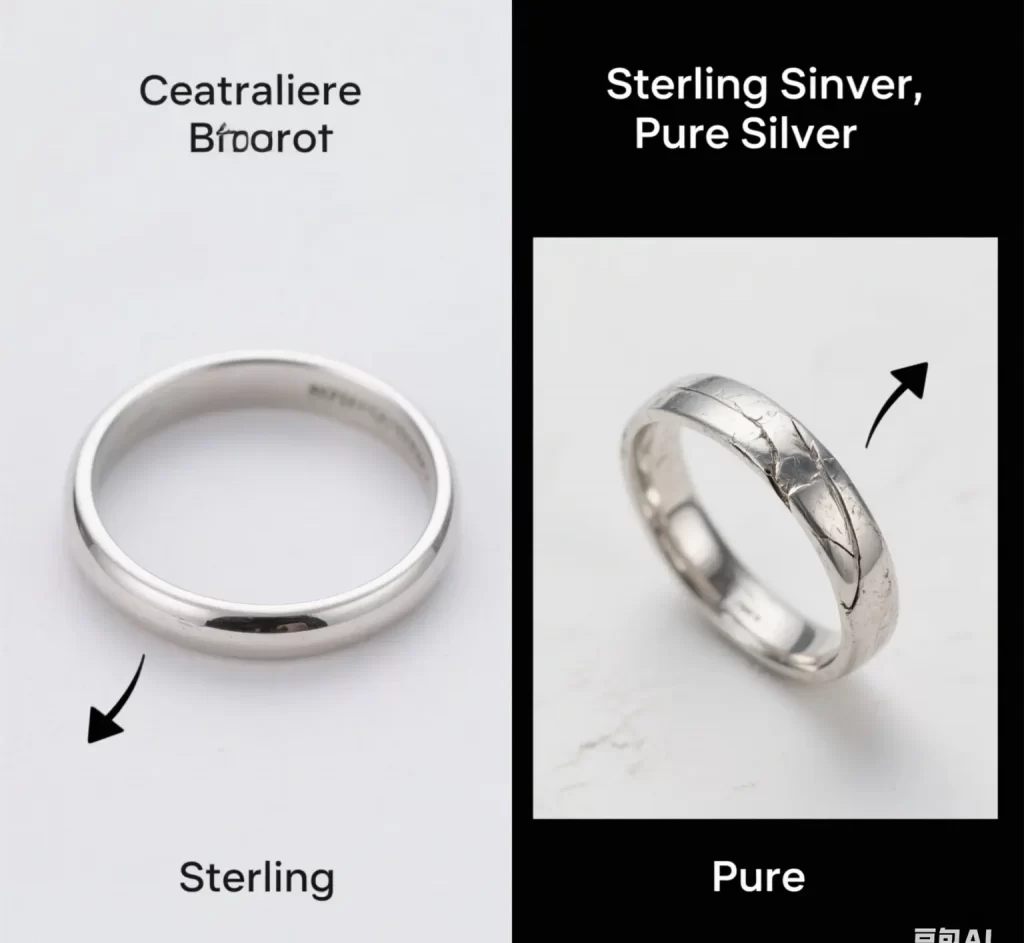
In the sterling silver vs silver durability contest, sterling silver far better withstands daily knocks and bumps than pure silver. In short, sterling silver far better withstands daily knocks and bumps than pure silver. Since pure silver is extremely malleable, it scratches and bends easily with little pressure. Sterling’s durable copper blend makes it a great fit for everyday wear items, like rings, earrings, and watches.
Whether you’re headed to the office, a workout, or a night on the town, you can wear sterling silver without a second thought. Pure silver is more appropriate for earrings or necklaces you don’t wear every day.
Cleaning both metals require a periodic cleaning to remove tarnish and maintain their luster. Sterling can become dull or tarnished due to sweat or air exposure, but can be instantly revived with a simple polish. Pure silver requires less frequent cleaning but is more susceptible to denting or scratching with frequent use.
In terms of toughness for daily wear on a wedding band, bracelet, or cufflinks, sterling tends to be more durable.
3. Differences in Luster and Look
At first sight, it’s challenging to distinguish between sterling silver and pure silver. Both types shine beautifully, but pure silver offers a glossier and whiter appearance with a more pronounced mirroring effect. In contrast, sterling silver can develop a softer, slightly grayer color over time due to the copper content hidden within the silver alloy. Visual differences are subtle but important in the sterling silver vs silver comparison. At first sight, it’s challenging to distinguish between them.
Some buyers appreciate the bright, crisp appearance of pure silver jewelry, while others prefer the more traditional look associated with quality sterling silver jewelry. Consumers typically choose based on personal taste and budget.
Artificial or natural light can significantly affect how these metals appear. Under sunlight, pure silver glimmers with an almost frosty glint, while sterling silver showcases a warm, rich sheen that shimmers beautifully indoors. The best choice ultimately depends on the aesthetic you desire for your jewelry collection.
4. Understanding Tarnish Factors
When comparing sterling silver vs silver tarnish resistance, pure silver is indeed much more resistant to tarnish compared to sterling. Tarnish is a natural and common occurrence, a very fine layer of silver that forms when the metal comes into contact with air or sweat. Pure silver is indeed much more resistant to tarnish compared to sterling. Sterling’s copper mix can oxidize with air, water or skin oils, creating a dark patina on the metal’s surface.
In environments such as Los Angeles, known for its smog and humidity, sterling jewelry may tarnish quickly. A simple soft cloth and a gentle cleaner will remove most tarnish easily, leaving your silver shiny and new.
To reduce tarnishing, keep your silver in dry, air-tight bags. Pure silver is less prone to tarnishing, and when it does occur, the tarnish is less pronounced and easier to remove. Sterling will develop dark or greenish splotches, while pure silver will only appear slightly cloudy.
5. Best Uses for Each Type
The sterling silver vs silver usage guide suggests that for fine jewelry not worn on a daily basis, pure silver is ideal. For fine jewelry not worn on a daily basis, pure silver is ideal for use in pendants, lockets or collector coins. Sterling silver is more suitable for pieces worn every day—wedding bands, charm bracelets, even flatware.
Makers like HonHo Jewelry in China use 925 sterling silver to design waterproof, non-tarnish pieces and custom styles, mixing style with lasting power. Sterling is fantastic for larger, more intricate pieces, as the added metals bring more strength to the design to hold shape and detail.
If you want to wear a piece regularly, sterling is the better, more durable option. Pure silver will bring a new level of indulgence to your most treasured artifacts. Whether it’s all the time or only part of the time, you can beautifully feature it.
6. Price and Investment Thoughts
Pure silver has a higher cost per gram, owing to the increased silver content. This makes it more favorable for anyone hoping to invest or resell later on. Sterling’s budget-friendliness allows you to purchase more design and size for the same price. In the sterling silver vs silver investment analysis, pure silver has a higher cost per gram, owing to the increased silver content.
Market fluctuations can affect both sides of the coin, so to speak, but pure silver does have a more stable long-term value. Collectors and investors consider silver content, weight, and market demand.
Sterling provides better value for daily use, while pure silver is the better choice for those interested in a long-term investment.
7. Reading Silver Hallmarks
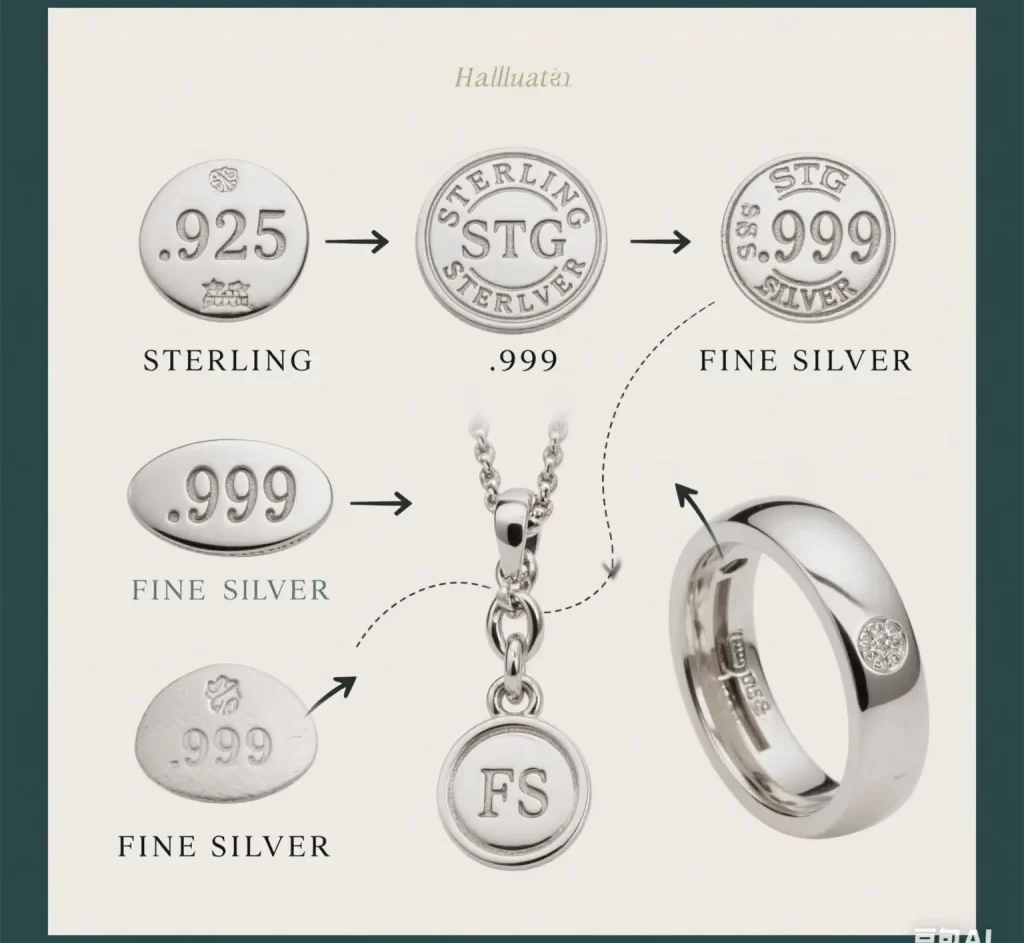
The majority of silver jewelry and cookware are marked with hallmarks—tiny engravings that indicate the metal’s purity. Sterling silver will be hallmarked as “.925,” “92.5,” or “STERLING.” Pure silver items have markings such as “.999” or “FINE SILVER.
These marks are your first line of defense in identifying genuine value and steering clear of impostors. Look for consistent, level stamps in inconspicuous areas, such as the interior of a band or the back of a pendant.
Well known brands and makers, like HonHo Jewelry, rely on these marks to assert their authenticity and quality. The hallmark will provide information on where and when the piece was made, giving you more of the story and value.
Why Mix Metals with Silver?

Mixing metals with silver has a long history in jewelry and metalwork, especially in places like Los Angeles where trends and durability both matter. Mixed metals with silver – While pure silver can be bright, beautiful, and classic, it’s too malleable and susceptible to scratches. To combat this, jewelers have been combining silver with other metals for centuries.
This process known as alloying renders silver stronger, more malleable, and in some cases alters its aesthetic and value. We dive deep into why alloying is important and how it has influenced the silver you know and love today below.
The Reason for Alloying
Altering the Composition
Adding other metals such as copper to silver affects its strength dramatically. Sterling silver, the most common variety, contains 92.5% silver and 7.5% in other metals. This alloy prevents silver from cracking or bending under everyday use.
It is more manageable to work with and polish alloyed silver for artisans. That translates into more intricate and imaginative jewelry pieces. With the right blend, silver can take on a deeper, richer tone. Alloying reduces the material cost, allowing artisans to provide high-quality pieces at more affordable price points.
Common Metals Added to Silver
Copper and zinc are the most common metals added to silver. Copper not only increases hardness, but imparts a slight reddish tint to silver. Zinc has a tendency to lower the melting point which speeds up production.
Certain combinations produce a much whiter appearance for silver, while other combos create a warmer tone. Understanding what’s in the blend is important, as many individuals are allergic to metals such as nickel.
Benefits of Adding Copper
Benefits of Adding Copper
Copper increases the durability of sterling silver. It aids pieces in maintaining their shape and prevents silver from tarnishing quickly. Adding copper helps maintain a lower cost, too.
Some individuals can develop dermatitis from copper if worn in jewelry.
Exploring Non-Tarnish Alloys
New technology has produced silver alloys that barely tarnish. Companies such as Argentium mix a small amount of germanium in for increased luster and lower maintenance.
These alloys perform exceptionally well in daily-wear jewelry and significantly reduce maintenance time.
How to Identify Real Silver
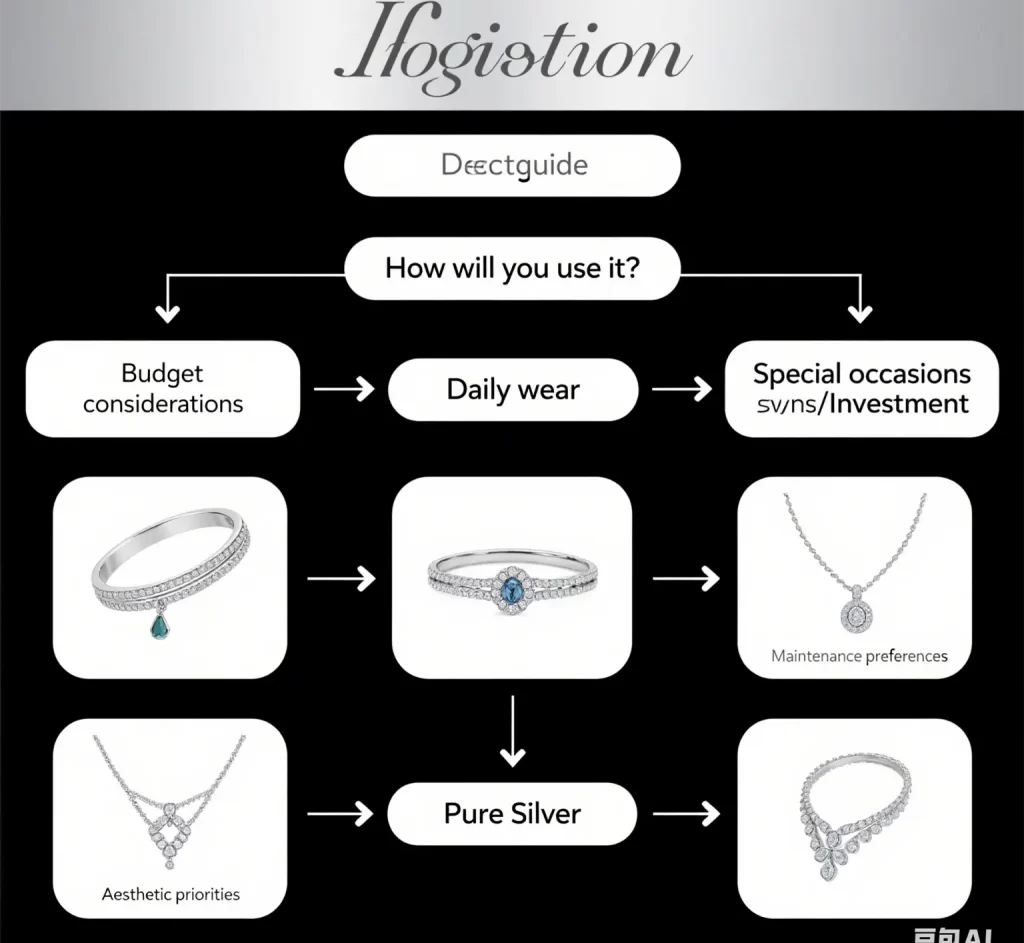
As with most things, knowing how to identify real silver is key. Use it when you’re buying, selling, or just to check your own collection at home. Not every piece of silver is created equal, but a few simple tricks can help you distinguish the real stuff from the fakes.
Look for stamps to determine authenticity. Aside from avoiding scams, performing simple home tests is another way to make sure you’re using the real deal.
Look for Quality Stamps
First and foremost, look for stamps of quality. Virtually all genuine sterling silver is stamped with “925”, “STERLING”, or “STER”. This is the mark that indicates the piece is 92.5% pure silver, which is the standard in the U.S.
Some pieces additionally include a maker’s mark or brand stamp. Reputable makers and established brands never use sloppy, ambiguous stamps. This is how U.S. Law requires silver items to be marked.
In other nations, hallmarking regulations can vary widely, so it’s useful to at least be familiar with what’s typical in your home country. Quality stamps increase resale value and assure buyers that they know what they are purchasing.
Simple Home Tests for Silver
You can check silver at home using easy tests:
- Use a strong magnet—real silver is not magnetic.
- Or apply a small amount of bleach to the item. If it is, indeed, sterling silver, it will turn black.
- Tap it lightly—it should produce a clear, high ring if it’s real silver.
- Take the vinegar test. If the finish turns a different color, it is probably plated.
Additionally, consider luster and scent. Counterfeit silver will have a frosty appearance or an offensive metallic odor.
When to Get Professional Testing
If you have an expensive or antique piece, have it professionally tested. Professional testing labs can use tests such as X-ray fluorescence to definitively identify silver content.
Professional tests are helpful for peace of mind and insurance/resale purposes.
Finding Trustworthy Silver Sellers
Choose reputable dealers that have excellent customer reviews and a long business history.
A trustworthy seller will accept returns and have a clearly posted return policy. Avoid offers that are just too good, sellers with no track record, or no confirmable physical address.
Keep Your Silver Gleaming
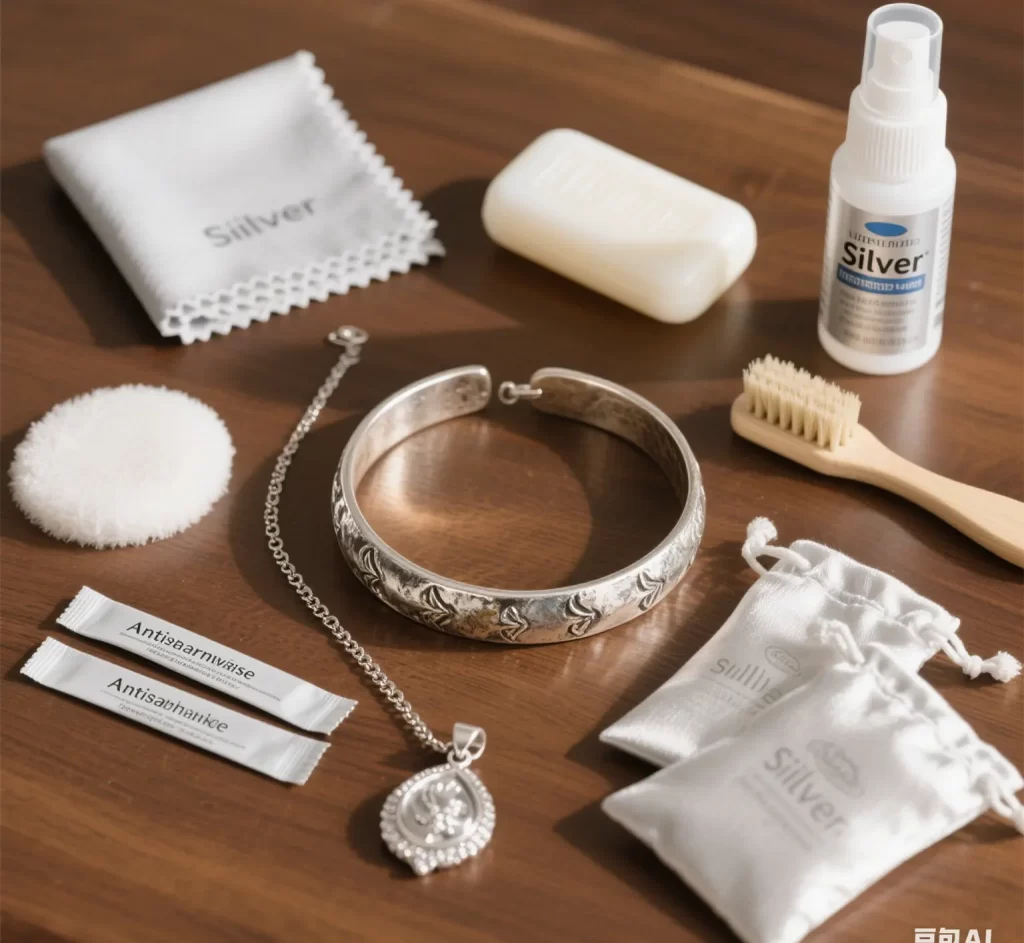
Both sterling silver and pure silver need a little extra attention if you want to keep them shining bright. Their needs are a bit different.
Sterling silver is an alloy of 92.5% pure silver and 7.5% other metals, such as copper or zinc. That gives it more strength than pure silver, but it can still tarnish over time due to exposure to air, moisture, and chemicals.
While pure silver, 99.9% pure, is softer and thus less likely to tarnish, it’s not suitable for everyday wear. Routine maintenance keeps both unique and conventional pieces in great condition for as long as possible, shining their brightest.
Key tips for keeping silver shining:
- Clean pieces with a soft cloth and mild soap.
- Dry jewelry well after cleaning.
- Store each item alone in a soft pouch.
- Use commercial silver cleaners as needed.
- Avoid wearing silver in the pool or shower.
Gentle Cleaning for Pure Silver
Pure silver retains its brightness when cleaned gently with mild soap and warm water. To avoid scratching, use a soft cloth free of abrasives to remove accumulated dirt and grime.
After cleaning, dry the piece immediately. This prevents tarnishing, water spots and keeps the silver as brilliant as possible.
Polishing Your Sterling Pieces
Polishing sterling silver jewelry requires a specific approach. To polish sterling silver, choose a cloth specifically designed for jewelry polishing.
Don’t use any harsh chemicals as they will eventually remove the finish. A light polishing with the appropriate cloth will eliminate tarnish while restoring luster to silver.
HonHo Jewelry specializes in custom pieces using a specially designed waterproof, non-tarnish sterling that requires less maintenance.
Smart Ways to Prevent Tarnish
To keep tarnish at bay, consider these smart strategies:
- Keep silver dry and away from damp air.
- Store in anti-tarnish pouches.
- Wear your silver often.
- Remove before swimming or cleaning.
Use is one of the best ways to keep tarnish at bay. It happens much more quickly in humid locations, so dry storage is essential.
Best Practices for Silver Storage
When it comes to storage, keep silver in a cool, dark place. To prevent scratches and tarnish, wrap each piece in a soft cloth, avoiding contact with other metals.
This will help prevent jewelry from tarnishing.
Other Silver Terms Explained
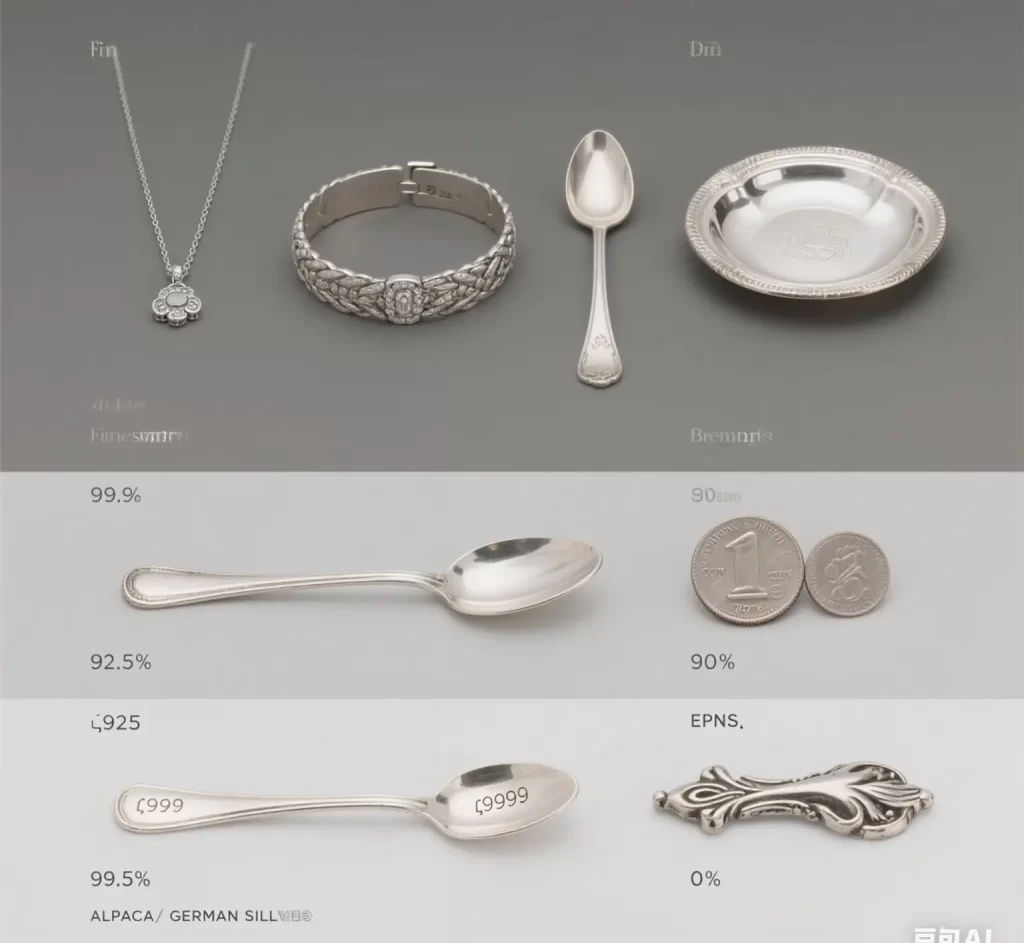
Silver is made in all types and understanding the proper terminology protects consumers from making expensive errors. The chart below explains some other silver-related terms you may come across in stores or online. Each kind has a profound impact on the value of a piece.
It additionally affects how it tarnishes over time and whether or not it can cause skin allergies.
|
Term |
Silver Content |
Common Markings |
Typical Uses |
|---|---|---|---|
|
Fine Silver |
99.9% |
999, .999 |
Bullion, high-end jewelry |
|
Sterling Silver |
92.5% |
925, STERLING |
Jewelry, flatware |
|
90% |
900, COIN |
Antiques, collectibles |
|
|
Silver Plated |
Thin layer |
EPNS, Plate |
Tableware, decor |
|
Nickel Silver |
0% |
Alpaca, German |
Cutlery, instruments |
Understanding Coin Silver
Coin silver, usually stamped with “900” or “COIN,” was produced from melted U.S. Coins prior to the 20th century. It is made of 90% silver and 10% copper. Collectors seek these objects not only for their artistic qualities, but for their antiquity, historical associations, and connections to former U.S. Paper currency.
Compared to today’s sterling, there is less silver in coin silver and it does not have the “925” stamped on it. Even so, its historical significance can render it coveted by antique enthusiasts.
What Silver Plated Means
As opposed to sterling, these objects are made of a thin layer of silver over a less expensive metal core. This thin layer is usually deposited through electroplating. The value is significantly less than solid silver because only the outer layer is made of genuine silver.
Marks such as “EPNS” (Electro Plated Nickel Silver) make it easier to spot plated items. You’ll encounter this term frequently on lower end tableware and giftware, where appearance is prioritized over the intrinsic silver value.
Nickel Silver Is Not Silver
Nickel silver, referred to as Alpaca or German silver, contains no silver at all. Nickel silver is an alloy of copper, nickel, and zinc. Makers love it for its durability and tarnish resistance.
It’s difficult to tell apart from genuine silver, so make sure to look for stamps and markings. It’s made its way into flatware, costume jewelry, and musical instruments. Understanding the distinction between the two ensures that buyers don’t get blindsided and pay too much.
Sterling Silver vs Silver: Making Your Perfect Choice
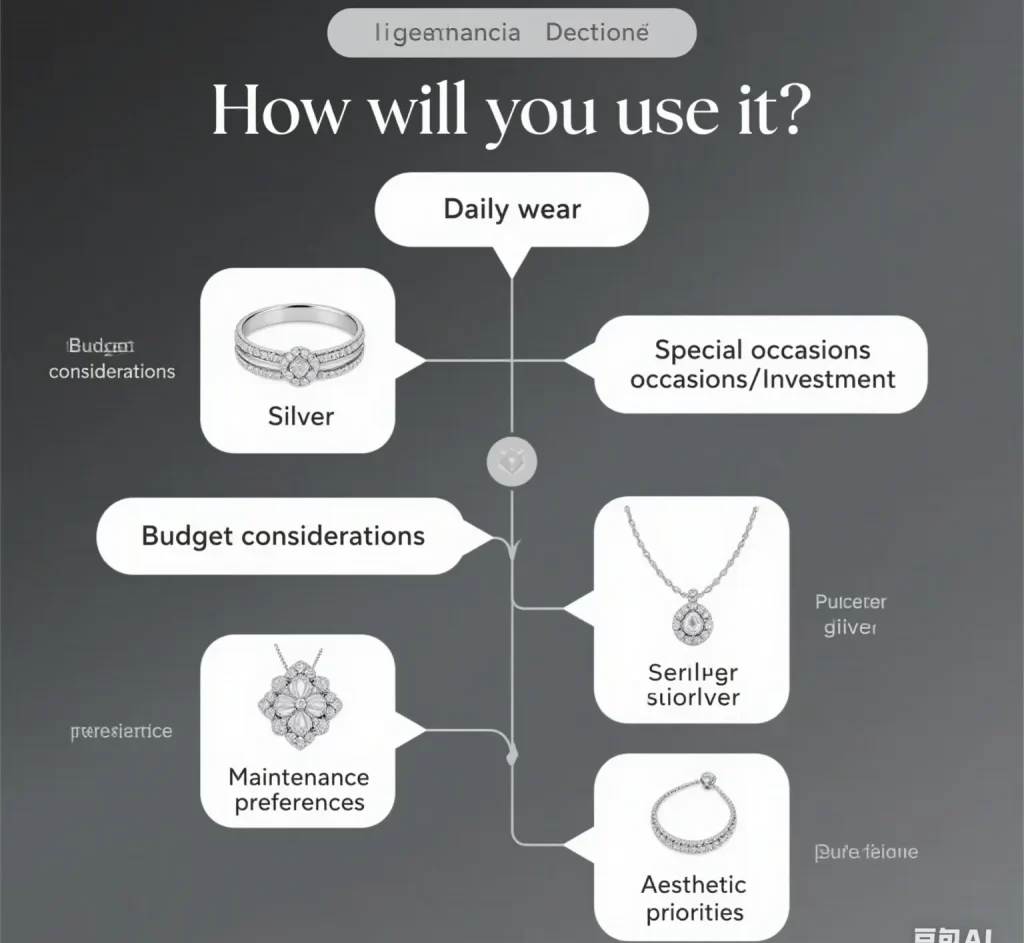
Deciding to buy quality sterling silver jewelry versus pure silver is more than just choosing a color or luster; understanding the key differences in silver metal purity helps narrow down the best fit for your needs.
- Type and purity of silver (sterling, fine, coin or silver-filled)
- Durability for daily wear or special events
- Personal taste and style
- Budget limits and price differences
- Ethical sourcing and sustainability
- Maintenance needs and tarnish resistance
Consider How You’ll Use It
Important to consider is how you’ll be using your new silver piece. Sterling silver is an alloy containing 92.5% pure silver. It is most often alloyed with copper or zinc to make it stronger, letting pieces withstand the rigors of everyday use.
Fine silver, marked 999, is a softer metal and works best for items worn only occasionally. Activities like sports, cooking, or outdoor work can speed up tarnish and wear, making hardier alloys a smart pick for active lifestyles.
Matching Silver to Your Budget
Silver price immediately changes based on purity, design, and where you purchase. You will find that sterling silver offers a better balance of quality and price, and fine silver or collectible designs may be pricier.
HonHo Jewelry specializes in one of a kind beautiful pieces made in 925 silver, brass, copper, gold, and bronze. It’s even easier to select what works best for your budget! Step 1—Identify your budget. Then, determine whether you require a higher-purity piece, or whether a carefully crafted alloy will suffice.
Personal Style and Aesthetics
Sterling silver’s bright gleam works with traditional or contemporary style. Fine silver does offer a deeper tone but requires greater maintenance.
Pair new items with what you already have, or go for looks that are in vogue, such as gold vermeil or mixed-metal combinations. With HonHo’s custom options, you can mix and match styles, so your jewelry perfectly complements your personal style.
Thinking About Ethical Sourcing
Each year it becomes more common for buyers to inquire about the origins of their silver. Choose brands that practice ethical mining, utilize recycled metals, or have third-party certifications.
Selecting these helps to improve better practices and reduce harm to our planet.
Conclusion
Both materials deliver beauty and quality, but they serve different purposes. Pure silver has a luxurious, old world brilliance, but is highly malleable and can scratch and bend easily. Sterling silver durability Since sterling silver contains less silver, it has less tendency to scratch, and thus it holds up better for rings, chains, and kitchenware.
People choose sterling because it’s less expensive and more durable. Some people prefer pure silver for its shine and old-timey appeal. Identify the fakes with simple tests, such as the magnet test or ice test. Looking after your silver Clean and polish all silver regularly with a soft cloth, and store it in dry, safe places. If you want your jewelry to hold up to every day wear. Sterling is the most effective. Want an unusual gift or a collectible coin? Pure silver is just a little different. Find out more, or visit some of our favorite trusted retailers to find your next piece.
Frequently Asked Questions
What is the main difference between sterling silver and pure silver?
What is the main difference between quality sterling silver jewelry and pure silver? Pure silver, known as fine silver, is 99.9% silver, while quality silver alloy offers more durability, making it ideal for silver jewelry items.
Is sterling silver real silver?
Is sterling silver real silver? It is made of 92.5% pure silver and is a quality silver alloy popular in jewelry and household goods due to its strength.
Why is pure silver not used for most jewelry?
First, pure silver is very soft and bends easily, while quality sterling silver, which is a silver alloy mixed with metals like copper, is stronger and better suited for daily wear.
How can I tell if my silver is sterling or pure?
To determine if your silver is sterling or pure, look for the stamp; sterling silver jewelry is often marked with a ‘925’ or ‘Sterling’ symbol, while pure silver jewelry is usually indicated as ‘999’ or ‘Fine Silver’.
Does sterling silver tarnish more than pure silver?
Does sterling silver tarnish faster than pure silver? We can’t have that in quality silver jewelry, as pure silver tarnishes almost not at all.
Is sterling silver safe for sensitive skin?
Most people consider quality sterling silver jewelry safe. However, some may react to the copper content or other metals blended within the sterling alloy. Pure silver is less likely to irritate the skin.
Which is better for heirloom pieces: sterling silver or pure silver?
Which is better for heirloom pieces: quality sterling silver or pure silver jewelry? Quality sterling silver is more durable, retains its shape and lasts through generations with the right care.
share this recipe:
Still hungry? Here’s more

Jewelry Wholesale Suppliers Guide 2026 for Retailers
Understanding Wholesale Jewelry Suppliers What Is a Jewelry Wholesale Supplier? A jewelry wholesale supplier (or

Best Online Jewelry Wholesale Suppliers Guide 2026
What to Look for in Online Jewelry Wholesale Suppliers When you choose online jewelry wholesale

Best Wholesale Jewelry Suppliers Guide for 2026 Retailers
Key Factors When Choosing the Best Wholesale Jewelry Suppliers When you’re picking the best wholesale
Ready to Design Your Own Jewelry?
Have an idea in mind or need help shaping it? From sketches to finished pieces, our custom jewelry team will work with you step-by-step to bring your vision to life.
